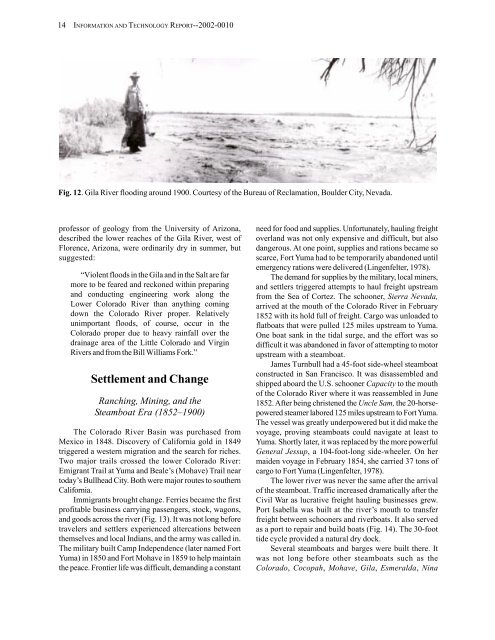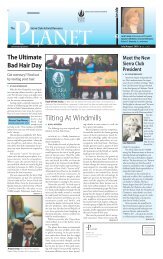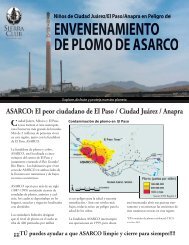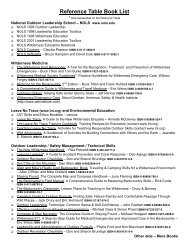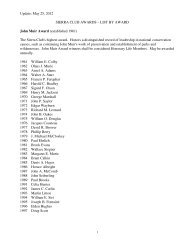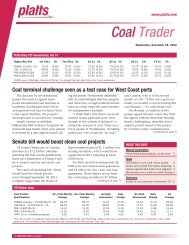Lost, A Desert River and its Native Fishes - Sierra Club
Lost, A Desert River and its Native Fishes - Sierra Club
Lost, A Desert River and its Native Fishes - Sierra Club
You also want an ePaper? Increase the reach of your titles
YUMPU automatically turns print PDFs into web optimized ePapers that Google loves.
14 INFORMATION AND TECHNOLOGY REPORT--2002-0010<br />
Fig. 12. Gila <strong>River</strong> flooding around 1900. Courtesy of the Bureau of Reclamation, Boulder City, Nevada.<br />
professor of geology from the University of Arizona,<br />
described the lower reaches of the Gila <strong>River</strong>, west of<br />
Florence, Arizona, were ordinarily dry in summer, but<br />
suggested:<br />
—Violent floods in the Gila <strong>and</strong> in the Salt are far<br />
more to be feared <strong>and</strong> reckoned within preparing<br />
<strong>and</strong> conducting engineering work along the<br />
Lower Colorado <strong>River</strong> than anything coming<br />
down the Colorado <strong>River</strong> proper. Relatively<br />
unimportant floods, of course, occur in the<br />
Colorado proper due to heavy rainfall over the<br />
drainage area of the Little Colorado <strong>and</strong> Virgin<br />
<strong>River</strong>s <strong>and</strong> from the Bill Williams Fork.“<br />
Settlement <strong>and</strong> Change<br />
Ranching, Mining, <strong>and</strong> the<br />
Steamboat Era (1852œ1900)<br />
The Colorado <strong>River</strong> Basin was purchased from<br />
Mexico in 1848. Discovery of California gold in 1849<br />
triggered a western migration <strong>and</strong> the search for riches.<br />
Two major trails crossed the lower Colorado <strong>River</strong>:<br />
Emigrant Trail at Yuma <strong>and</strong> Beale‘s (Mohave) Trail near<br />
today‘s Bullhead City. Both were major routes to southern<br />
California.<br />
Immigrants brought change. Ferries became the first<br />
profitable business carrying passengers, stock, wagons,<br />
<strong>and</strong> goods across the river (Fig. 13). It was not long before<br />
travelers <strong>and</strong> settlers experienced altercations between<br />
themselves <strong>and</strong> local Indians, <strong>and</strong> the army was called in.<br />
The military built Camp Independence (later named Fort<br />
Yuma) in 1850 <strong>and</strong> Fort Mohave in 1859 to help maintain<br />
the peace. Frontier life was difficult, dem<strong>and</strong>ing a constant<br />
need for food <strong>and</strong> supplies. Unfortunately, hauling freight<br />
overl<strong>and</strong> was not only expensive <strong>and</strong> difficult, but also<br />
dangerous. At one point, supplies <strong>and</strong> rations became so<br />
scarce, Fort Yuma had to be temporarily ab<strong>and</strong>oned until<br />
emergency rations were delivered (Lingenfelter, 1978).<br />
The dem<strong>and</strong> for supplies by the military, local miners,<br />
<strong>and</strong> settlers triggered attempts to haul freight upstream<br />
from the Sea of Cortez. The schooner, <strong>Sierra</strong> Nevada,<br />
arrived at the mouth of the Colorado <strong>River</strong> in February<br />
1852 with <strong>its</strong> hold full of freight. Cargo was unloaded to<br />
flatboats that were pulled 125 miles upstream to Yuma.<br />
One boat sank in the tidal surge, <strong>and</strong> the effort was so<br />
difficult it was ab<strong>and</strong>oned in favor of attempting to motor<br />
upstream with a steamboat.<br />
James Turnbull had a 45-foot side-wheel steamboat<br />
constructed in San Francisco. It was disassembled <strong>and</strong><br />
shipped aboard the U.S. schooner Capacity to the mouth<br />
of the Colorado <strong>River</strong> where it was reassembled in June<br />
1852. After being christened the Uncle Sam, the 20-horsepowered<br />
steamer labored 125 miles upstream to Fort Yuma.<br />
The vessel was greatly underpowered but it did make the<br />
voyage, proving steamboats could navigate at least to<br />
Yuma. Shortly later, it was replaced by the more powerful<br />
General Jessup, a 104-foot-long side-wheeler. On her<br />
maiden voyage in February 1854, she carried 37 tons of<br />
cargo to Fort Yuma (Lingenfelter, 1978).<br />
The lower river was never the same after the arrival<br />
of the steamboat. Traffic increased dramatically after the<br />
Civil War as lucrative freight hauling businesses grew.<br />
Port Isabella was built at the river‘s mouth to transfer<br />
freight between schooners <strong>and</strong> riverboats. It also served<br />
as a port to repair <strong>and</strong> build boats (Fig. 14). The 30-foot<br />
tide cycle provided a natural dry dock.<br />
Several steamboats <strong>and</strong> barges were built there. It<br />
was not long before other steamboats such as the<br />
Colorado, Cocopah, Mohave, Gila, Esmeralda, Nina


